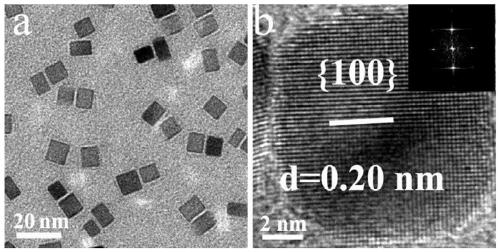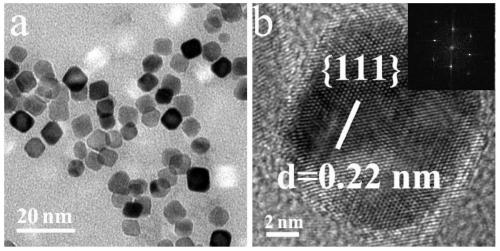Applications of Palladium Nanomaterials
A nanomaterial, palladium nanotechnology, applied in nanotechnology, nanotechnology, nanomedicine, etc., can solve problems such as increasing the complexity of the preparation process, limiting enzyme activity, and affecting antibacterial effects
- Summary
- Abstract
- Description
- Claims
- Application Information
AI Technical Summary
Problems solved by technology
Method used
Image
Examples
Embodiment 1
[0044] Preparation of Pd cubic nanomaterials: Dissolve 105mg of polyvinylpyrrolidone, 60mg of ascorbic acid and 300mg of potassium bromide in 8ml of water and add to the flask, stir and preheat at 80°C for 10min, then quickly add 3ml of dissolved 57mg of sodium chloropalladate The aqueous solution was continuously stirred at a constant temperature for 3 hours, centrifuged, washed with water for 3 times, and resuspended in the aqueous solution to obtain Pd cubic nanomaterials.
[0045] Preparation of Pd octahedral nanomaterials: 105mg of polyvinylpyrrolidone, 60mg of ascorbic acid and 60mg of citric acid were dissolved in 8ml of water and added to the flask. After stirring and preheating at 80°C for 10min, 57mg of chloropalladium acid was dissolved in 3ml using a syringe pump. An aqueous solution of sodium was injected into the above solution at a constant speed, continued to stir and react at a constant temperature for 3 hours, centrifuged, washed the solid with water for 3 tim...
PUM
| Property | Measurement | Unit |
|---|---|---|
| size | aaaaa | aaaaa |
Abstract
Description
Claims
Application Information
 Login to View More
Login to View More - R&D
- Intellectual Property
- Life Sciences
- Materials
- Tech Scout
- Unparalleled Data Quality
- Higher Quality Content
- 60% Fewer Hallucinations
Browse by: Latest US Patents, China's latest patents, Technical Efficacy Thesaurus, Application Domain, Technology Topic, Popular Technical Reports.
© 2025 PatSnap. All rights reserved.Legal|Privacy policy|Modern Slavery Act Transparency Statement|Sitemap|About US| Contact US: help@patsnap.com



